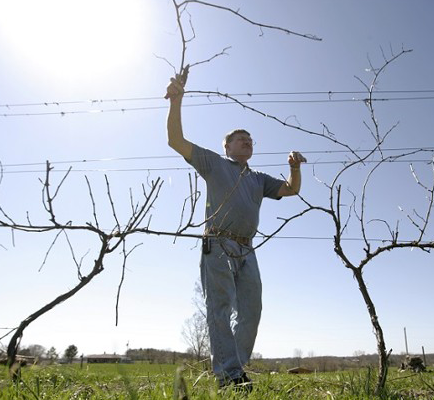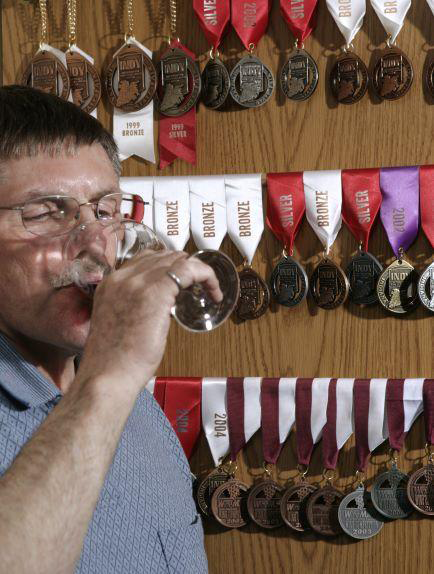

Excerpt from the Dayton Daily News
By Mark Fisher
Jim Brandeberry’s passion and commitment to his two very different — yet to him, immensely rewarding — careers were in full display in the basement of his home on a summer night in 1997, when I first met and interviewed him.
Brandeberry was founding dean of Wright State University’s College of Engineering and later launched his own winery in southern Clark County. He died Friday at his home near Enon at the age of 78. I wrote a news story about his passing on Saturday, and he was laid to rest yesterday, on Monday, Sept. 10.
In 1997, Brandeberry was serving as dean of WSU’s College of Engineering, and on the side, he was making fabulous, award-winning wines in his home. I was covering the Dayton area’s colleges and universities as the higher education reporter for the Dayton Daily News, and also writing a wine column for the newspaper on the side.
It was a great interview, and please let me pay tribute to Jim, known to his family as the “Lil' Olde Winemaker,” by sharing the full story from the Aug. 30, 1997 edition of the Dayton Daily News:
___________
Jim Brandeberry was never much of a drinker.
The dean of Wright State University's College of Engineering didn't care for liquor, so at parties, he'd carry around a glass of wine - "so it would look like I was drinking," he says.
Then in 1993, he and wife Sharon did a little winery-hopping while on vacation in the Finger Lakes region of upstate New York, sampling the wares of seven or eight vineyards in the region.
Hmmm, Brandeberry thought. Not bad. I wonder....
Shortly after his return, Brandeberry slipped into the Wine Works wine shop in Springfield and picked up a book on making wine at home.
- RELATED: Upstart winery snags ‘Best Ohio wine’ top prize in an upset; Brandeberry wins for ‘Best Fruit Wine’
Now we'd hate to generalize here, and we certainly wouldn't want to stereotype any group of people, but - oh well, let's face it: engineers love to tinker. Most have never met a design they couldn't improve upon, or a process they couldn't do better.
"I looked at that book and thought, 'I can do that,'" Brandeberry said.
He invested a modest sum in the basic supplies he needed to make wine in the basement of his rural home north of Yellow Springs ("you can get started for less than $100," he says). And he began eyeing the grapevines and fruit orchards surrounding his home, as well as the Internet sites and local wineries where he could purchase grape juice. Then he started tinkering.
Last year, he developed enough confidence to enter a half-dozen wines in the American Wine Society's Annual Amateur Wine Competition, and came away with a coveted medal — a silver — for a fruity, slightly pink baco noir. The competition drew 1,000 entries from around North America, and only about 110 captured medals.
"I was surprised," Brandeberry said. "Pleasantly."
However his efforts haven't always been so successful.
His first attempt at fermentation turned out not so peachy. It was a wine made of homegrown peaches, and Brandeberry ended up throwing away the whole batch. "It didn't taste bad, but it had an off odor," he said. A wine made from Niagara grapes fared better.
In case you're wondering, there's nothing illegal about home winemaking — as long as you don't get too ambitious or start selling your product on the street corner. Any individual can legally make up to 100 gallons of wine each year for home consumption, or 200 gallons for a household with two adults. A gallon equals about five standard-sized bottles of wine.
- RELATED: Brandeberry Winery’s ‘Red Affair’ to benefit Honor Flight, veterans (May 2016)
Brandeberry hasn't pushed the limit yet. The most wine he made was in 1995, when he fermented about 50 gallons.
Meanwhile, Brandeberry's basement — unfinished when he launched his fermentation career — went through a metamorphosis.
"That first year, I had to build a wine rack to store my bottles. The next year, I needed more room, so I built a second wine rack. Then I decided I needed a wine cellar, so I built one. Then we decided we needed a wine-tasting room, so...."
Tiptoe down Brandeberry's basement steps now and ease open the drywall-and-Styrofoam door to his wine cellar, and you'll hear a soft, muted percolating sound. That's a batch of blueberry wine fermenting.
The 10 pounds of fruit for this batch was not exactly estate-grown. "I was walking through Meijer and noticed that blueberries were on sale," Brandeberry said, smiling.
Brandeberry — who came to Wright State in 1969 as an assistant professor and worked his way up the ranks, serving as dean for the last 11 years — said the winemaking allows him to dust off some of the chemistry knowledge of long ago. But he also likes the blend of precision and creativity that winemaking demands.
- RELATED: Wines, vines and fine times are only a short drive away (March 2015)
"That's the neat thing," he said. "I like to cook, but I don't like to follow recipes. Making wine is kind of like cooking: you mix all these things together, keep tabs on it, add things to it to alter the taste...."
When he's in full winemaking mode — adding a bit of sugar or sweet, unfermented juice to a fermented batch to achieve just the right level of sweetness or fruitiness — he'll often scurry up the steps to have Sharon taste the various sample batches. Then, he descends again to his "laboratory" for a bit more tinkering.
Brandeberry has some tinkering to do over the next couple of months, trying to fill a production quota of sorts. His youngest daughter is getting married in October.
At the reception, she wants to serve her father's wine.

